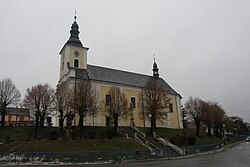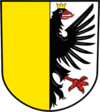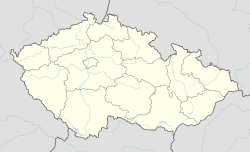Velké Opatovice
|
Velké Opatovice (German: Groß Opatowitz) |
|||
|---|---|---|---|

Saint George church
|
|||
|
|||
| Coordinates: 49°36′43″N 16°40′20″E / 49.61194°N 16.67222°E | |||
| Country |
|
||
| Region | South Moravian | ||
| District | Blansko | ||
| First mentioned | 1308 | ||
| Component settlements |
List
|
||
| Government | |||
| • Mayor | Ing.Kateřina Gerbrichová | ||
| Area | |||
| • Total | 25.93 km2 (10.01 sq mi) | ||
| Elevation | 376 m (1,234 ft) | ||
| Population (1-1-2015) | |||
| • Total | 3,864 | ||
| Time zone | CET (UTC+1) | ||
| • Summer (DST) | CEST (UTC+2) | ||
| Postal code | 679 63 | ||
| Website | http://www.velkeopatovice.cz | ||
Velké Opatovice is a small town and a commune in the Moravian region of the Czech Republic.
Velké Opatovice is situated in Blansko District, about 260 km southeast of Prague and 120 km north of Vinna. The neighboring villages Bezďečí, Brťov, Korbelova Lhota, Svárov, and Velká Roudka are also part of the commune. The city of Boskovice also stands nearby.
The first evidence of the settlement dates to 1308, when a contract shows the purchase of a town called Opatovice by the nearby Cimburk castle, today a ruin. The 'Velké' part of the name (meaning "great") was added in 1888, and the town became a city in 1969. The most significant estates in Velké Opatovice are those of the Vězník, Salm, and Herberštein families.
The city's baroque castle dates to 1757. It belonged to the Salm family, and passed to the Herbersteins in the late 18th century. The Herbersteins added the castle's neobaroque tower. The castle passed to municipal control after 1945, and it was damaged by a fire that destroyed one block in 1978. The castle now serves as the town museum, with a memorial hall devoted to academic sculptor Carl Otáhal who lived in Velké Opatovice for 30 years. In 2007, the burnt part of the building was replaced with an elliptical auditorium. The castles grounds include beautiful parkland containing plant and animal species and a statue of Bedřich Smetana.
The city's major church is of interest for its baroque decoration and altar relief of St. George fighting the dragon. The church was built in the late 18th century on the site of a 14th-century Gothic temple.
The centre hosts a permanent exhibition on the historical development of cartography. Subjects include the philosophy entailed in imagery of the Earth's surface on maps, and the history of the production of maps. The main auditorium displays a giant relief-map of historical Moravia and Silesia.
Two km north of the city is Smolenska reservoir, which can be used as a bathing lake. The surrounding countryside is also used for hiking, cycling, and skiing in winter.
1.5 km south of the city stand the remnants of a 513m tall Bronze Age building. In the rockface below the sculptor Karel Otáhal inscribed relief texts by the poet Petr Bezruč and the composer J.B. Foerst.
...
Wikipedia



